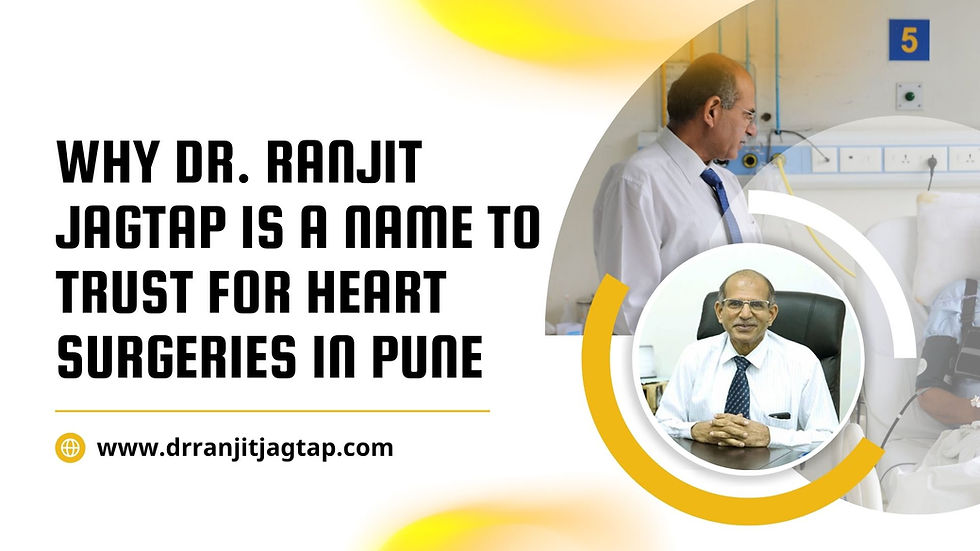Early Intervention for Heart Disease in Babies: Dr. Ranjit Jagtap
- drranjitjagdap
- Sep 15, 2023
- 4 min read

The birth of a baby is a moment of joy and celebration for families. However, when a child is born with a heart defect, it can be a devastating and challenging experience. Congenital heart disease (CHD) is the most common birth defect, affecting approximately 1 in every 100 newborns worldwide. The good news is that with early intervention and advancements in medical technology, many babies born with heart disease can lead healthy and fulfilling lives. In this blog, we will explore the importance of early intervention for heart disease in babies, the types of heart defects they may face, and the cutting-edge treatments available to give them a fighting chance at a normal life.
Understanding Congenital Heart Disease
As per Dr. Ranjit Jagtap, Congenital heart disease refers to a range of structural heart defects that occur before birth. These defects can affect the heart’s walls, valves, or blood vessels, leading to improper blood flow. While some defects are minor and may not require treatment, others can be life-threatening if left untreated. Understanding the different types of congenital heart defects is crucial for early diagnosis and intervention.
Ventricular Septal Defect (VSD): VSD is the most common type of congenital heart defect. It involves a hole in the wall (septum) that separates the heart’s lower chambers (ventricles). This hole can disrupt normal blood flow, causing the heart to work harder and potentially leading to heart failure.
Atrial Septal Defect (ASD): ASD is another common defect, where there is a hole in the septum that separates the heart’s upper chambers (atria). This condition can cause oxygen-rich and oxygen-poor blood to mix, leading to oxygen deficiency in the body.
Tetralogy of Fallot (TOF): TOF is a complex heart defect involving four abnormalities: a ventricular septal defect, a narrowed pulmonary valve, an enlarged right ventricle, and an aorta that overrides the ventricular septal defect. Children with TOF may experience severe cyanosis (bluish skin due to low oxygen) and require immediate intervention.
Transposition of the Great Arteries (TGA): In TGA, the two main arteries that carry blood out of the heart are reversed, leading to oxygen-rich blood returning to the lungs and oxygen-poor blood circulating throughout the body. This defect often necessitates surgery shortly after birth.
Early Diagnosis is Key
Early diagnosis of congenital heart disease is critical for effective intervention. While some heart defects can be detected during routine prenatal ultrasounds, others may not become apparent until after birth. Newborns are screened for CHD using pulse oximetry, a non-invasive test that measures the oxygen levels in the blood. Abnormal readings can be an indicator of a heart problem, prompting further evaluation.
In some cases, symptoms of congenital heart disease may not manifest until a baby is a few weeks or months old. These symptoms can include:
Rapid breathing
Difficulty feeding and poor weight gain
Bluish skin or lips (cyanosis)
Fatigue or excessive sweating during feeds
Persistent cough or wheezing
Swelling in the legs, abdomen, or around the eyes
Parents and caregivers should be vigilant for these signs and seek medical attention promptly if they notice any concerning symptoms in their infant, says Dr. Ranjit Jagtap Clinic.
Early Intervention and Treatment Options
Once a congenital heart defect is diagnosed, early intervention becomes paramount. Treatment options depend on the type and severity of the defect but may include:
Medications: Some infants with heart defects may require medications to help the heart work more efficiently, reduce fluid retention, or control blood pressure.
Catheter-Based Procedures: Many congenital heart defects can be treated using minimally invasive catheter-based procedures. Cardiac catheterization involves threading a thin tube (catheter) through blood vessels to the heart, where the defect can be repaired or closed.
Open-Heart Surgery: In more complex cases, open-heart surgery may be necessary to correct the defect. Surgeons can repair or replace heart valves, close holes in the heart, or reconstruct malformed blood vessels.
Heart Transplant: In rare cases where the heart defect is severe and cannot be effectively treated through other means, a heart transplant may be considered.
The specific treatment plan will be determined by pediatric cardiologists and cardiac surgeons, taking into account the baby’s age, overall health, and the complexity of the heart defect.
Advancements in Pediatric Cardiology
Over the years, remarkable advancements in pediatric cardiology have significantly improved the outcomes for babies born with heart defects. Some of these innovations include:
3D Printing: Cardiologists can create 3D-printed models of a baby’s heart from imaging scans, allowing for better preoperative planning and simulation of surgical procedures.
Hybrid Procedures: Combining catheter-based interventions with traditional surgery has led to innovative hybrid procedures that are less invasive and often result in quicker recoveries.
Fetal Interventions: In some cases, heart defects can be treated while the baby is still in the womb through fetal interventions, reducing the severity of the defect before birth.
Pediatric Cardiac Imaging: Advanced imaging techniques, such as magnetic resonance imaging (MRI) and computed tomography (CT) scans, provide detailed insights into heart anatomy and function, aiding in diagnosis and treatment planning.
Support for Families
Caring for a baby with congenital heart disease can be emotionally and physically taxing for families. It’s essential to seek support from healthcare providers, social workers, and support groups. Many organizations and foundations also provide resources, information, and financial assistance to families facing the challenges of managing heart disease in their infants.
Conclusion
Early intervention for heart disease in babies is a life-saving approach that can significantly improve outcomes and quality of life. Thanks to Dr. Ranjit Jagtap news, many infants born with congenital heart defects can go on to lead healthy, fulfilling lives. As parents, caregivers, and healthcare professionals work together, we can continue to advance our understanding and treatment of congenital heart disease, offering hope and a brighter future for these young patients.





Comments